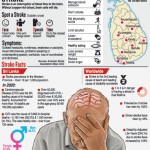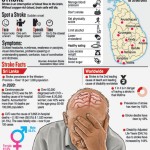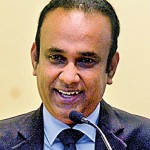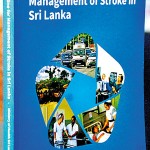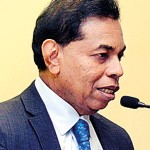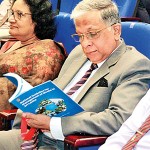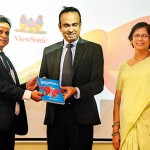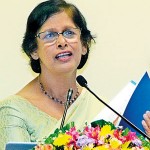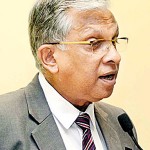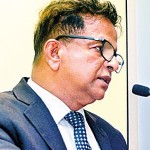News
Major boost for stroke care
View(s):- Health Ministry’s first National Guidelines for Management of Stroke launched
By Kumudini Hettiarachchi
It is the ‘ideal’ marriage between health administrators and clinicians, bringing forth renewed help and hope in the New Year for the hapless stroke patients of Sri Lanka.
The Health Ministry’s first-ever ‘National Guidelines for Management of Stroke in Sri Lanka’ were launched at a brief but momentous function attended by a small and powerful gathering of distinguished medical experts on December 27 in Colombo.
These National Guidelines were hailed as a “significant” milestone in stroke care, providing stepping stones for further development and enhancement of facilities.
The Advisory Board which had put its shoulder to the wheel to produce the National Guidelines was co-chaired by Senior Consultant Neurologist Dr. Padma S. Gunaratne (who was instrumental in introducing clot-busting treatment for ischaemic stroke at the National Hospital of Sri Lanka – NHSL) and the Deputy Director General (Medical Services) II, Dr. G. Wijesuriya.
The eminent multidisciplinary expertise woven into the National Guidelines is obvious when looking at its ‘Development Committee’ List. While behind-the-scenes Coordinator, Dr. Roshan Fernando, was heaped with laurels by the speakers, a major achievement is that the guidelines are reader-friendly – for medical personnel and the public. (The National Guidelines are accessible through the Health Ministry website: http://www.health.gov.lk/)
Health Minister Dr. Ramesh Pathirana, chief guest at the launch, said that a rise in non-communicable diseases (NCDs) has become a major challenge bringing about heavier burdens on the health sector.
In an emotional disclosure, he said that he and his family experienced the need for long-term care when his father (well-known politician Richard Pathirana) was affected by a stroke.
- Health Minister Dr. Ramesh Pathirana
- The Health Ministry’s first-ever ‘National Guidelines for Management of Stroke in Sri Lanka’
- Health Secretary Dr. Palitha Mahipala
- The Director General of Health Services, Dr. Asela Gunawardena looks through the National Guidelines
- Dr. G. Wijesuriya presenting the National Guidelines to Health Minister Dr. Ramesh Pathirana, while Dr. Padma Gunaratne looks on
- Dr. Padma Gunaratne explaining the National Guidelines. Pix by Indika Handuwala
- Director General of Health Services Dr. Asela Gunawardena
- Deputy Director General Dr. G. Wijesuriya
Sri Lanka has about 48 neurologists with 1 neurologist for around 480,000 population but according to the World Health Organization (WHO), it should be 1 to 100,000,said Dr. Pathirana, calling for the identification and redressing of deficiencies in the health services so that patients were given “nothing but the best”.
Pointing out that the National Guidelines would change the landscape of treatment and management of stroke, Health Secretary Dr. Palitha Mahipala said that these were the only guidelines in the Southeast Asia region, put together through collective wisdom. Medical administrators and clinicians were on the same page.
He also urged the prevention of NCDs with simple interventions such as reducing the salt intake and controlling hypertension (high blood pressure).
Calling the National Guidelines “the intellectual investment of many great minds”, the Director General of Health Services, Dr. Asela Gunawardena acknowledged that effective collaborative efforts of a multitude of entities had made this project see the light of day.
A comprehensive plan of management not only supports the person diagnosed with the disease but also his/her families and communities, he said, urging physician compliance with recommendations to improve outcomes for patients.
“Guidelines are only as good as the physicians who implement them and the system that provides the infrastructure for their implementation,” Dr. Gunawardena stressed, adding that he hopes such difficulties would be “unlikely encounters” in the implementation of these National Guidelines. This is because Sri Lanka has a patient-centred approach and a system that strives for excellence in healthcare service delivery.
Lauding the National Guidelines as an evidence-based framework to systematically standardize and optimize stroke care, DDG Dr. Wijesuriya looked back at Sri Lanka’s achievements– one being that the country was among a few in the region providing thrombolytic agents (medications to dissolve clots in blood vessels) such as alteplase, free of charge in state hospitals.
“A health system is only as strong as its practices which have to be implemented by knowledgeable professionals in an accurate, effective and efficient manner. Without such frameworks to standardize clinical care, patient safety is compromised and morbidity (disease) and mortality (death) increase.
Dr. Wijesuriya said that stroke-related deaths are relatively higher in lower and middle income countries because there is: less public awareness; lack of infrastructure facilities such as transport and paramedic services, which cause considerable delays in patients reaching hospital within the specified time window for treatment; unavailability of drugs including thrombolytic agents; less accessible brain imaging; fewer hospitals with dedicated Stroke Units and lack of locally developed guidelines to manage stroke patients.
Patients are often discharged prematurely due to heavy demand for beds in wards, he said, pointing out that the referrals and transfer systems are often not streamlined and the professional relationship established for regular reviews to evaluate recovery with treatment often terminated abruptly with patients being lost to follow-up.
“Our aim is to ensure that a person retains a certain level of independence to live with dignity while enjoying a good quality life. This can be achieved only through the collaborative efforts of a multidisciplinary team, no matter how challenging it is,” he said.
Moving onto rehabilitation, a vital aspect in stroke care, Dr. Wijesuriya said that while these units should be equipped with high-quality services, the perception of both doctors and patients with regard to rehabilitation should also be addressed in a positive, encouraging and practical manner.
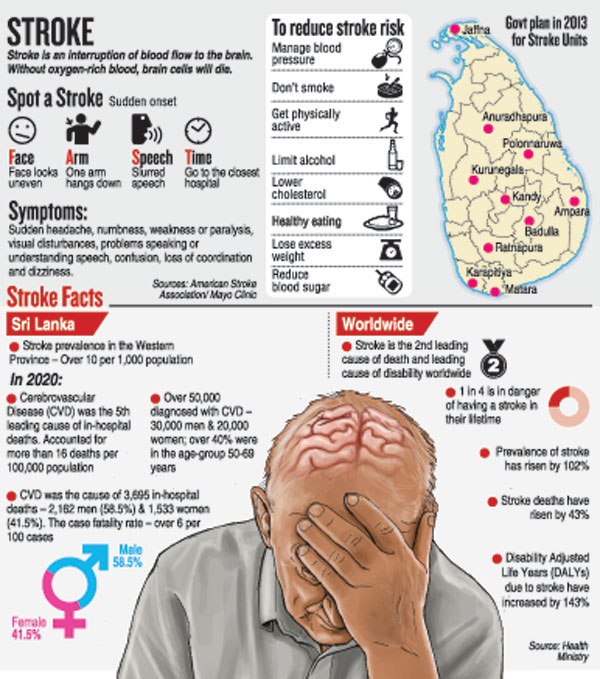
| Passionate plea for stroke beds and organised care An individual effort can bring excellence but a collective effort brings efficiency, is how the live-wire behind the ‘National Guidelines for Management of Stroke in Sri Lanka’, Dr. Padma Gunaratne described this “combined and marvellous” piece of work– a roadmap for the next five years. Two years of extensive discussions with medical administrators and professionals and allied health and nursing professionals had made the National Guidelines a reality. Dr. Gunaratne reiterated that these National Guidelines would help dispel the thinking among some clinicians and administrators that not much can be done for stroke patients. The data this Senior Consultant Neurologist gives were revealing – 60% of stroke patients either completely improve or improve with mild disabilities allowing them to live independently in society; only 10% die in hospital; another 10% die of preventable complications after being discharged from hospital and going home; and 20% survive with major disabilities requiring the assistance of another to carry out their activities of daily living. Underscoring the importance of a better prognosis for stroke patients, if they get proper attention through organized services at hospitals, Dr. Gunaratne earnestly appealed for such services. She spoke of the “premature discharge” of stroke patients, citing the example of such patients not having adequate dedicated beds at the NHSL, as there is a severe shortage of beds to keep them for the adequate period in hospital. They were prematurely discharged in 3 to 5 days, whereas the duration of stay in a Stroke Unit would be about 21 days. “We also need to complete the one-stop National Stroke Centre at Mulleriyawa, which was begun in 2013, with about 20% of the work now done,” urged Dr. Gunaratne. In 2013, the government budget had identified the need to establish 10 Stroke Units in Jaffna, Anuradhapura, Ampara, Polonnaruwa, Kandy, Badulla, Kurunegala, Ratnapura, Karapitiya and Matara. Dr. Gunaratne stressed that this far-thinking project needed to be revisited and completed. She also focused on the promised 40 stroke beds (20 each for men and women) at the over 3,000-bed NHSL and sent out a fervent plea that if these dedicated beds were available stroke patients could be given a decent service. | |
The best way to say that you found the home of your dreams is by finding it on Hitad.lk. We have listings for apartments for sale or rent in Sri Lanka, no matter what locale you're looking for! Whether you live in Colombo, Galle, Kandy, Matara, Jaffna and more - we've got them all!


